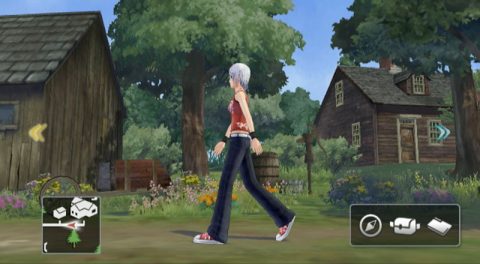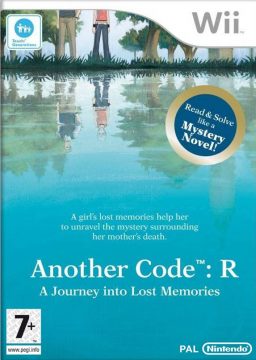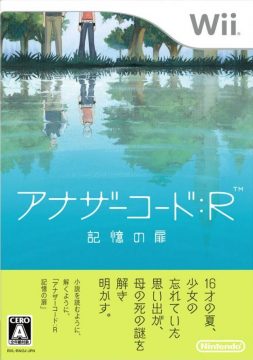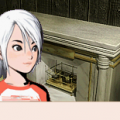- Trace Memory
- Another Code: R – A Journey Into Lost Memories
- Another Code: Recollection
Four years after Nintendo published the first game, CING brought Ashley back for another adventure in Another Code: R. This time, however, U.S. gamers were left out in the cold. Although Nintendo published the sequel in Japan and Europe, it never reached North America. This is particularly unfortunate given how much the sequel improves on its predecessor – indeed, this is likely the pinnacle of CING’s “interactive mystery novels.” Die-hard fans of Kyle Hyde might debate the point, but it’s hard to argue that this is their most technically polished adventure.
Another Code: R features beautiful graphics done in the style of a watercolor painting. The camera no longer watches the action from a top-down perspective, but instead uses a combination of side-scrolling and over-the-shoulder viewpoints. There are no pre-rendered environments – now you can zoom in on any object by pointing at it and hitting “A,” which will result in Ashley’s usual commentary. The soundtrack is a lot less irritating and far more enjoyable. For most of the game, it reflects the beautiful, vacation-like atmosphere of the setting, but it amps up as the game goes on, conveying more tension and danger when you reach the later chapters of the story. And the game is far longer as well. Depending on your puzzle-solving abilities and other decisions, this one can last anywhere from 13 to 18 hours.
As with the first game, you have your choice of control options. This time out, you can either use the D-pad to move Ashley around her environments, or you can point at the on-screen arrows with the Wii remote and hold the A button to move in the direction indicated.
As stated above, Another Code: R is played from a different perspective than Trace Memory was. You travel around the region by following paths and roads in a side-scrolling perspective. If the road curves or if you want to head down a branching path at an intersection, the camera will rotate to keep Ashley in a side view. Once you enter a building, you’ll be given an establishing shot of the structure, and then you’ll enter an over-the-shoulder third-person view. In this perspective, you’ll find that Ashley can rotate 90 degrees in any direction. The camera rotates with her, allowing you to see every side of a given room or strucure. You can move to new parts of the building by pressing up on the D-pad to move towards a door/hallway, or by clicking on the arrow at the top of the screen. Entering any building or advancing to a new area of the interior always results in a transition effect where all of the objects in your current room fade away, and the new room rapidly slides into place around you. It’s sort of like changing settings mid-scene during a stage play.
The game is full of cool transitions that take advantage of the new 3D perspective. Perhaps the most impressive is when Ashley rapidly travels along certain roadways – the camera moves behind her head at this time, and you seem to rush through swirling leaves and surroundings, with new buildings springing up out of the ground as you slow down and reach your new location. It’s difficult to explain, but impressive to see in action. It’s just a great-looking Wii game all around.
As with the first game, you can click on anything to have Ashley examine it. This is primarily reserved for indoor areas in Another Code: R, but is also possible is certain outdoor environments. This time, however, you’ll zoom in on the item in question once you click on it, and Ashley has a far more interesting variety of actions and reactions. This is partly because Ashley is fully animated during all of her dialogue. Whereas the first game used static artwork and had her only blinking and flapping her mouth before changing to a new pose, the new fully-rendered Ashley will throw her head back, gesture around the area, roll her eyes, laugh, recoil in horror, or do whatever the situation calls for. This increase in personality is further enhanced by the fact that she gives a lot more commentary on her surroundings. This time around, Ashley has more jokes, more awe to express, and more sarcastic remarks.
Ashley is more sarcastic in general, actually. One of the highlights of the game’s writing is how she’s grown up in a realistic fashion between games. Another Code: R takes place two years after the first one, and Ashley is now 16. Her character model is ganglier, and her attitude is stronger. She’s far more outspoken and more prone to talking back to the people around her, and she’s developed a new love of music. One of the defining character traits of Ashley in this adventure is the love she’s developed for the guitar. The European localization team even took care to keep her strictly American this time around, so you won’t find any of the references to “mum” or her “flat” that felt out-of-place in Another Code: Two Memories.
Ashley’s new maturity and attitude means that when her father disappears on her shortly after the first game, she’s not about to take it lying down. That’s right – after being absent from her life for 11 years, Richard lasted one whole year with Ashley before taking a new research job and moving away again. During the gorgeous cinematic opening, we learn that Richard came back to see her on weekends for the first six months of his new job, but after that, he stopped coming home altogether.
Just like in the first title, the story opens with Ashley receiving a message from her father and a package containing the new DAS – this one updated to resemble the DSi. This time out, Richard wants her to come camping with him at Lake Juilet, the recreational destination that is also the site of his new lab’s operations. And Ashley’s initial reaction is to give him the cold shoulder. She’s tired of her deadbeat dad, and she’s having none of his half-hearted attempts to reach out to her. After some pushing, Jessica manages to talk Ashley into taking the trip. Unfortunately, the trip begins with Ashley getting her bag stolen the second she steps off of the bus. And wouldn’t you know it – Richard doesn’t show up to greet her. Again.
“This isn’t going to be another story of Ashley searching for her father, however. She meets up with him halfway into the first chapter of the game, and it isn’t long before she lays into him for his fatherhood-related failures. Yet along the way, some of the locations she sees around the lake prompt her to experience confusing flashbacks of her mother. Everything comes together when Richard explains that Sayoko took little Ashley to this very lake shortly before her death, back when Ashley was just three. Those flashbacks are genuine memories, and Richard wants Ashley to focus on remembering why Sayoko came here all those years ago. He’s not just asking this because he wants to feel closer to his dead wife – he’s asking it because he’s come to believe that someone at the Lake Juliet laboratory was responsible for convincing the villian in the first game to kill Sayoko. This, we ultimately learn, is the reason why he left Ashley after only a year of living with her – he received a mysterious e-mail indicating that there was more to Sayoko’s murder waiting within the walls of the lab known as JC Valley. Yes, it seems we have a full-fledged conspiracy on our hands.
With D having moved into the great beyond, Ashley is instead joined by a new sidekick – a 13-year-old boy named Matthew Crusoe. Matthew has run away from home and come to Lake Juliet in search of his missing father, who vanished five years prior after his resort business at the lake crumbled away beneath him. So once again Ashley must team up with a boy whose predicament is not unlike her own. Matthew can’t seem to remember much about his father, and he recalls even less about his sister Kelly. He also has a bad habit of lying in order to protect himself, which makes Ashley’s attempts to help him all the more difficult.
The mystery surrounding Matthew’s family and his father’s business is both one of Another Code: R‘s strengths and its greatest weakness. On the one hand, it’s a compelling story with a lot of surprising developments and significantly more emotional weight than D’s story offered in the first title. The scene in which Matthew finally remembers the horrible truth behind his sister’s disappearance – that she fell into Lake Juliet and drowned while Matt was supposed to be watching over her, and he subsequently blocked the event from his mind out of guilt – is one of the emotional high points of the series as a whole.
Unfortunately, Matthew’s story fails to reach any kind of satisfactory conclusion – a frustrating development when you compare it to how beautifully the game wraps up Ashley’s tale. Even Matthew’s father’s fate is never determined. Instead, Matthew is pushed aside during the final chapters of the game in order to focus exclusively on Ashley’s story. The producers at CING once indicated that they hoped to one day continue Matthew’s story in a follow-up game. Given CING’s current status, however, it’s sadly unlikely that Matthew will ever be seen again.
To be fair, putting all of the focus on Ashley’s predicament in the final chapters was probably the right call. It puts both Ashley and the player into a situation where they feel alone and unsure of who to trust as the story develops. Every time Ashley starts to feel that she can trust someone, that individual is promptly incapicitated by an unseen assailant. It’s a strong climax in which Ashley forms a new bond with her father as they are both menaced by the central villian.
Call it Screenwriting 101 through the lens of a video game. As you’d expect from any good sequel, Another Code: Rraises the stakes for Ashley and her family as a whole. In the first game, Richard had a false memory about Sayoko’s death implanted into his brain. In this one, things get far worse when he has valuable memories wiped from his mind. In addition, whereas the first game only put Richard’s mind at the mercy of the “Another” machine, this time Ashley herself is forced to climb into the device and deal with its manipulations.
The mastermind behind this is nearly as easy to identify early in the game as the villain in the first one. On the upside, the game does try to throw you off the trail with a few misleading hints, so it’s slightly less blatant, but savvy gamers will likely catch onto who is behind it all pretty fast. Whereas Trace Memory‘s nemesis came off as a pretty traditional one-note villain, our new person-behind-the-scenes proves to be a far more threatening presence who callously manipulates the emotions of the various players throughout the story.
Yes, it’s frustrating that Ashley is SO SLOW to recognize the culprit once we get into Chapter 7 and the evidence starts piling up. On the other hand, though, the first game made a point of how trusting Ashley is, which does make it more plausible … even though she should really know better after what happened on Blood Edward Island. Regardless, the journey and destination are still worth the experience. Even if you go in armed with knowledge of who the bad guy is, that still doesn’t spoil the many side characters, numerous subplots and various characters motivations you uncover along the way. Another Code: R is an adventure worth taking, and one that manages to be even more satisfying if you look at everything in your surroundings.
There are many details hidden in the environments that add to the story. For example, there’s really no reason to examine everything on Richard’s desk, as most of it will do nothing to aid in your progression. Do so, however, and Ashley will eventually stumble across a photo of a hippie-looking young Richard rocking out with a guitar, and will feel a sudden kinship with her father through this surprising love they share for the instrument. Little details like this, which are not strictly necessary to the plot or gameplay, manage to contribute a lot of depth to the characters herein.
Whereas Trace Memory was largely confined to the Edward Mansion, Another Code: R takes Ashley all over the place. Aside from exploring the campgrounds immediately surrounding Lake Juliet, Ashley also wanders through an adjoining neighborhood, into abandoned corporate buildings, up to the top of a clock tower and down through multiple levels of the underground lab. The scope is widened even further by the numerous subplots and characters she interacts with. In comparison to Trace Memory, which had only six characters (including Ashley) in the whole game, the sequel provides roughly three times as many people to converse with.
Yes, that does mean that the text-based dialogue mechanic is back from the first game. It works pretty much the same way, with points of interest being highlighted so that you can bring them up again by clicking on them. Conversations tend to last even longer in Another Code: R than they did in the first game, but the detailed character animations help to make the game feel distinct from typical Japanese “visual novels” while simultaneously removing the sense of tedium that could sometimes set in when you got into one of the lengthier 10-minute exchanges with someone in the first game. Of course, individual mileage may vary.
Another thing that helps keep the conversations interesting is that you can actually choose some of Ashley’s responses this time around. Occasionally, you’ll be presented with a couple of options as to how you want to react or what you want to say to someone. Usually, the dialogue will only vary slightly, and events will unfold in largely the same way. There are a few instances in which your responses can genuinely affect events in the game, however. Early on, when you encounter a park ranger and explain that your bag was stolen upon your arrival, you have the opportunity to choose what size Ashley will tell him the bag was. Choose the correct size, and the ranger will return your bag to you partway through the game with the majority of your belongings intact. If you lie or simply don’t remember the correct size of her bag, however, he will deliver some unrecognizable bag to you later in the game, and your belongings will remain lost to the annals of time. The tenor of Ashley’s conversations with other characters can also be altered in minor ways depending on how you treat them, or in, some cases, how your responses affect their treatment of you. This is a far cry from the complexity of Mass Effect’s dialogue trees, but still a welcome bit of interactivity. On the flip side, during the climax when Ashley is placed into the Another machine, you seem to be given some important decisions to make about Ashley’s future… but these decisions are false. This one tantalizing segment of the game turns out to be a disappointing case of “but thou must.”
The minor variations you can create in the story before this point still offer up additional replay value, which is good, because there’s only one ending this time. No matter what path you take through the game, the conclusion will remain the same. There is another incentive to play a second time, though. Just like in Trace Memory, you’ll get new, different messages detailing the backstory of the area on your second playthrough.
Of course, one of the main reasons adventure gamers will want to experience this title is the puzzles. The ability to overlay multiple photographs with transparency effects is back in full force and put to even smarter use here than it was in Trace Memory. There is also a new “combine” mechanic for items, which is nothing new to the genre but a welcome addition to the series that increases the complexity of many otherwise-easy puzzles.
The main attraction is really the puzzle events that make unique use of the Wii remote, however. As with Trace Memory, you are often placed into puzzle screens where you are given no direction as to what you should do, and it’s simply up to you do what feels the most natural and obvious. One early puzzle requires you to combine a rope with a life preserver, and then you’re placed into a puzzle screen where you have to figure out how to make these items collect a bag floating out on the lake. This is one of the most obvious examples – of course you’re going to fling the life preserver out onto the water, ideally with a side-armed toss. Later examples get progressively more obtuse. All told, Another Code: R has a more challenging set of puzzles than Trace Memory featured, and the progression to higher levels of difficulty is smoother as the game progresses. Even so, none of the puzzles are quite as “out there” as Trace Memory‘s reflection puzzle.
Early in the adventure, Ashley gets an item called the “TAS” – the True Another System – which looks suspiciously like the Wii remote. This leads to some of the most entertaining puzzles of the game. The most oft-repeated mechanic is one in which you have to aim the Wii remote at an electronic lock and then unlock it by pressing in the button commands that appear. At first, this is simple stuff – A, B, 1, 2. But then you see something that says “3,” and you’re left to wonder where the “3” button is on your remote. Well, there’s a 1 button, a 2 button and a + button… get the picture? That’s only the start of how clever these get, though. You wouldn’t want to have some of these spoiled for you, but the example below is a definite favorite.
Late in the game, Ashley has to upgrade the TAS using a “module” that looks suspiciously similar to something else that comes with the Wii. You’ll also have to unlock a puzzle box that has some strange symbol-bearing shapes placed in locations that seem to mirror the buttons on your Wii remote, which forces you to figure out the combination to “unlock” your own remote. One of the final puzzles tasks you and Ashley with placing the TAS onto a device on a table. It’s amazing how precise the placement has to be – you have to put the Wii remote upright, but any slight incline or tiny movement will make it not qualify as matching the table on the screen. That means you can’t use a carpet or cushioned surface – you have to go to a real table or a countertop and stand it on end for a set amount of time for it to work. All told, Another Code: R contains some of the smartest and best usage of the Wii remote found on the system.
Another Code: R is a game full of mature storytelling, engaging characters, intelligent puzzles, beautiful scenery and even some lovely music. The overall theme of memory is even explored more deeply in this sequel, as the story explores how our memories define us and sometimes haunt us as well as how they create a sometimes-twisted image of the people and events who have passed through our lives. Though it can be predictable at times and long-winded at others, Another Code: R manages to improve on its predecessor many times over, offering a conclusion to Ashley’s story that is as emotionally satisfying as any novel should be.
Other Appearances
Since Nintendo published Ashley’s adventures, that opens up the potential for her to appear in the popular Smash Bros. series. Unfortunately, you won’t find Ashley as a playable fighter who can summon D to terrify her opponents or anything like that. Instead, she appears as an unlockable character trophy in Smash Bros. Brawl for the Wii. Ashley and a few other characters from Trace Memory also exist in Brawl as stickers that can improve the stats of your fighters if they are placed on the base of the characters’ trophies.
Interestingly, the Another Code games seem to share a universe with CING’s Hotel Dusk and Last Window. Pictures of Hotel Dusk characters appear in Another Code: R. Hotel Dusk, Another Code: R and Last Window also share references to “Pinkie Rabbit,” who is a cartoon character familiar to both Kyle Hyde in the late 1970s and Ashley Robbins in the late 2000s.
With any luck, we haven’t heard the last of CING or their characters. Unfortunately, Another Code: R failed to bring in decent sales numbers in either Japan or Europe. However, given that Nintendo seems have some degree of ownership over Ashley Robbins and Kyle Hyde, anything is possible.




